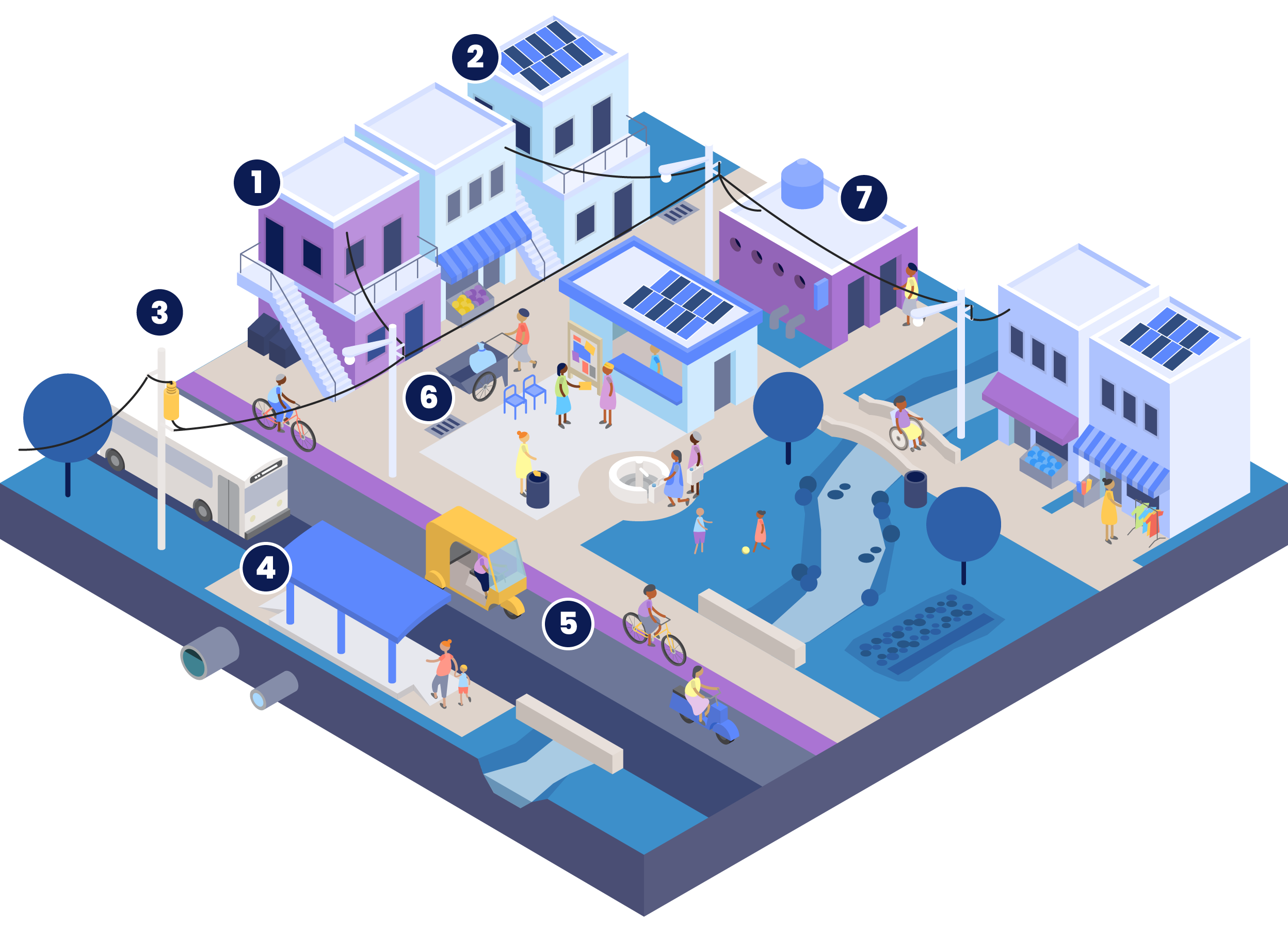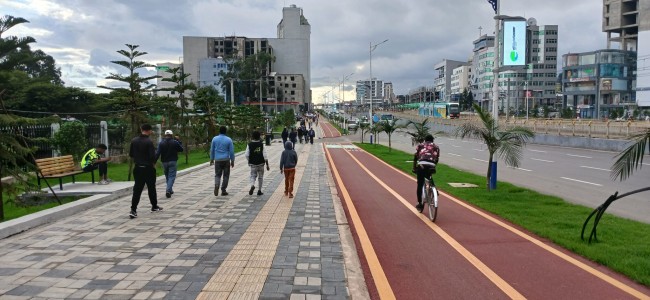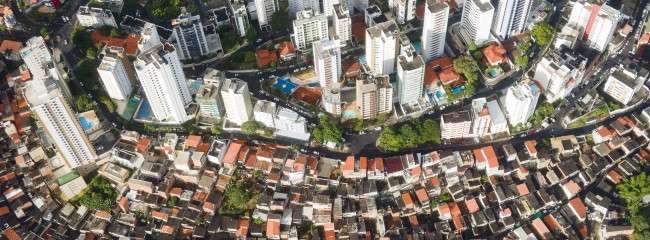A closer look at the cities system
Cities are a system of systems. They bring together deeply complex, interconnected networks of people, services and economic activity — from how we move around, power industries, and construct buildings, to how we govern societies, finance climate solutions, use and consume resources, and beyond.
The current state of the cities system
Cities are the source of a large share of greenhouse gas emissions and high levels of air pollution
The number of people living in cities is expected to increase by 2.5 billion between 2018 and 2050, by which point roughly two-thirds of the global population is expected to live in urban areas. Cities host many economically critical activities that consume energy, produce greenhouse gas (GHG) emissions and worsen air pollution, including transportation of people and goods, construction, lighting, heating and cooling buildings, pumping for water supply and wastewater systems, and industrial activity.
Cities account for over 70% of global carbon dioxide equivalent (CO2e), with the buildings and transport sectors in urban areas among the largest contributors. As cities grow, the infrastructure built to meet the needs of growing populations can lead to carbon lock-in for decades if it is not built in ways that minimize emissions.
It is also estimated that 91% of people in urban areas breathe polluted air that does not meet the guidelines of the World Health Organization. In 2019, exposure to unhealthy particulate matter led to an estimated 1.8 million excess deaths in cities, and exposure to nitrogen dioxide gas (NO2) pollution led to almost 2 million cases of childhood asthma, two-thirds of which occurred in urban areas.
While urbanization is often associated with higher consumption, cities have an opportunity to decarbonize and reduce polluting emissions at scale given the growing concentration of people and activities. Cities are key to halving global emissions by 2030, in line with the Paris Agreement’s commitment to keep warming to 1.5 degrees C (2.7 degrees F) above pre-industrial levels.
Urban form impacts sustainability
The physical form and layout of cities and how their growth is managed can have a significant impact on their emissions. For example, denser city centers can sometimes produce half the GHG emissions of suburban neighborhoods due to more walking and cycling infrastructure, higher availability of public transport and denser building forms that minimize the need for space heating and cooling.
Approximately 25% of urban GHG emissions could be reduced by 2050, as compared to business-as-usual levels, through integrated spatial planning for efficient and compact urban growth. In most regions, per capita GHG emissions in cities are lower than the national per capita GHG emissions of the countries where these cities are found.
Many cities are highly vulnerable to the impacts of climate change
Cities are also highly vulnerable to climate hazards like extreme heat, sea level rise and water risks like flooding and droughts. This can lead to food insecurity in urban food supply systems from decreased crop yields and increased urban populations.
By 2050, over 1.6 billion people in over 970 cities could suffer from extreme heat, with sustained temperatures reaching at least 35 degrees C (95 degrees F) for three consecutive months. Additionally, by 2050, over 800 million people in 570 coastal cities could be exposed to sea level rise of at least 0.5 meters and over 650 million people in over 500 cities will see a decline of at least 10% in freshwater availability.
Urban inequality exacerbates climate vulnerabilities
One in three city dwellers globally — over 1 billion people — already do not have reliable, safe or affordable access to basic everyday services and infrastructure like running water and sanitation, electricity, decent housing and transport to work and school. By 2050, another 2 billion city dwellers will require housing and basic services. The climate hazards described above are amplified for those who lack access to basic urban services.
The way cities grow, how they provide access to services and opportunities for all urban residents, and how they transition to being zero-waste have important implications for emissions, equity, public health and resilience.
The changes we need to implement by 2050
Plan urban land use to reduce emissions and increase climate resilience
Spatial planning and land use strategies that limit urban sprawl and promote more efficient utilization of urban land with higher densities, better connectivity to infrastructure and services, and preservation and enhancement of green and blue spaces can result in lower GHG emissions, higher resilience to climate risks, and improved equity.

Safe, reliable, and affordable mobility can facilitate access to jobs and opportunities. This can be done with 4) public transit access and 5) safer streets for pedestrians, cyclists and integrating informal transit. Improving 6) waste management and expanding access to services such as 7) managed sanitation can lead to healthier environments and communities.
Source: Seven Transformations for More Equitable and Sustainable Cities, World Resources Institute Ross Center for Sustainable Cities.
The world is currently witnessing widespread urban growth into natural habitats that support carbon storage, biodiversity zones and low-lying coastal areas. Urban land use planning, informed by data on climate risks, is an important lever to both reduce emissions and build resilience to climate hazards like heat and floods.
Increase access to resilient and affordable urban services and infrastructure
Inequality and climate action should not be separated, because improving access to basic urban services and infrastructure can simultaneously address the compounded challenges of increasing urban emissions, the urban services divide and vulnerability to climate risk. In order to be climate resilient in an inclusive way, cities must focus on closing the urban services divide that burdens poor and marginalized communities the most, making them highly exposed to climate hazards and environmental pollutants.
All key urban services and sectors — from land and housing to transport, energy, water, sanitation and waste management — are critical for achieving urban climate adaptation and mitigation equitably. Better sanitation and waste management can also reduce water pollution. Similarly, policies and investments that support cleaner urban transport, cleaner industry, low-carbon household energy, energy efficiency of buildings, and better municipal waste management can reduce key sources of outdoor air pollution.
Improve urban waste management and transition to zero-waste cities
According to the United Nations Environment Programme (UNEP), the estimated generation of municipal solid waste was 2.1 billion tonnes globally in 2023 and is expected to grow to 3.8 billion tonnes by 2050. Coupled with growing income levels and increased consumerism, global waste generation rates are expected to grow at twice the rate of population growth between now and 2050. If these trends continue, global solid waste-related emissions will increase incrementally to 2.5 billion tonnes of CO2e by 2050 unless effective zero-waste policies and programs are implemented.
Emissions from waste management — including CO2, methane (CH4) and nitrous oxide (N2O) — contribute about 5% of total GHG emissions. Municipal solid waste is a significant contributor to this, emitting methane as it decomposes without air. Solutions to minimize these emissions should begin with waste minimization programs. Thereafter, residual segregated waste could be managed through recycling programs and disposed of through strategies that minimize final disposal in landfills. Waste-to-energy projects could be implemented at urban landfills to capture methane as a source of energy.


